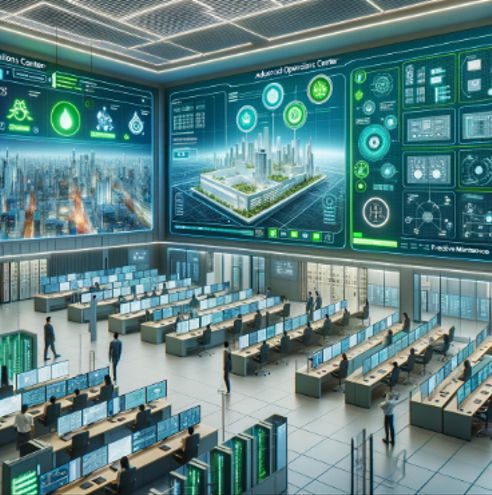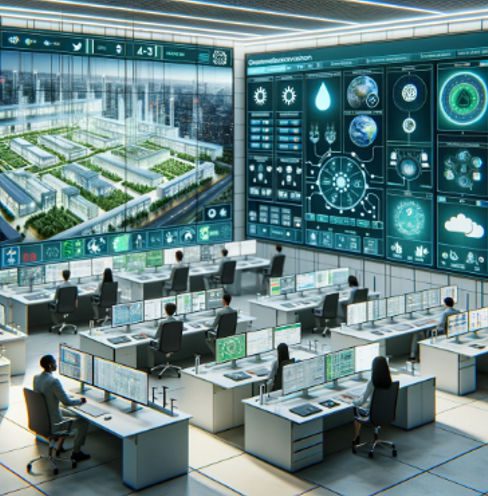Facility Management System: A Comprehensive Guide and process for maintaining
Facility management system streamlines and automates essential processes for maintaining, operating, and managing facilities. This comprehensive system offers features such as asset tracking, maintenance scheduling, space utilization optimization, and energy management.
By utilizing facility management software, businesses can enhance operational efficiency, reduce costs, and ensure regulatory compliance. Industries spanning from healthcare to education extensively rely on this technology to oversee their facilities effectively.
Moreover, the continuous advancements in facility management software technology have led to the integration of IoT devices for real-time monitoring and predictive maintenance capabilities.
Understanding the Role of a Facilities Manager
Responsibilities of a Facilities Manager
Facilities managers oversee building maintenance and operations. They ensure safety, functionality, and efficiency. This includes coordinating tasks like maintenance, repairs, security, and space allocation.
For example, if there’s a heating issue in an office building, the facilities manager organizes repairs for employee comfort. Facilities managers also ensure compliance with safety and environmental regulations. They oversee inspections and maintain records to meet industry standards.
Importance of Effective Facilities Management
Effective facilities management is essential for optimizing resources and creating a comfortable environment. Investing in proper reduces energy consumption and contributes to cost savings and environmental conservation.
Well-maintained facilities also enhance employee productivity and satisfaction. Facilities managers play a crucial role in ensuring business continuity during unforeseen events by implementing contingency plans to protect people and assets.


Key Features and Benefits of Facilities Management Software
Streamline Operations
Facility management systems automate work order management, making tasks like scheduling maintenance or repairs more efficient.
Facility managers can create, assign, and track work orders easily within the system. Automation reduces errors and ensures timely completion of tasks. It also improves operational efficiency by eliminating bottlenecks in the process.
Improve Efficiency
Facility management software improves efficiency by enhancing communication and collaboration among facility teams.
Real-time updates and notifications keep everyone informed about completed tasks and urgent issues, leading to quicker response times and faster issue resolution.
This software also fosters better teamwork among staff members working on different aspects of facilities management.
Gain Insights into Facility Performance
One of the key benefits of facilities management software is its ability to provide comprehensive reporting and analytics on various aspects of facility performance.
By leveraging data collected through the system, facility managers can gain valuable insights into areas such as resource utilization, equipment downtime trends, energy consumption patterns, and more.
These insights enable data-driven decision-making processes aimed at optimizing resources while maintaining high standards of service delivery within facilities.
For example,
- A facilities manager might use analytics from the software to identify areas where energy consumption can be reduced.
- The same information could help in planning preventive maintenance schedules based on historical equipment performance data.
Having access to detailed reports empowers managers with actionable intelligence for continuous improvement in their facilities’ operations.
Ensure Compliance with Regulations
Centralized documentation and tracking features offered by facility management systems play a crucial role in ensuring compliance with regulations and standards.
These systems allow for efficient storage and retrieval of important documents such as permits, certifications, inspections records, and other compliance-related information.
Work Order and Repair Management in Facility Systems
Importance of Work Order Management
Work order management is essential in facility management system. It helps organize and execute maintenance tasks efficiently. Facility managers can prioritize and assign tasks effectively,
improving productivity and operations. For instance, when equipment needs maintenance or repair, the work order system allows managers to generate service requests quickly.
This eliminates manual paperwork and phone calls, streamlining the process. It also enhances transparency by tracking pending tasks and their status, reducing delays in addressing maintenance issues and promoting staff accountability.
Enhancing Repair Management
Effective repair management is crucial for maintaining optimal functionality in facilities. An integrated system for managing repairs ensures timely resolution of maintenance issues, preventing minor problems from becoming major repairs.
Facility systems automate processes like generating repair requests and notifying relevant personnel. They also provide comprehensive tracking capabilities, ensuring no issue goes unresolved due to oversight or miscommunication.
Communication and Accountability
Automated notifications in facility management systems improve communication during work orders and repairs. They promptly inform all relevant parties about new or updated orders, preventing delays caused by missed messages or emails.
These notifications also promote accountability among staff members by providing real-time alerts about assigned tasks, reducing the need for constant supervision.


Preventive and Equipment Maintenance Strategies
Importance of Preventive Maintenance
Preventive maintenance is essential in facility management system to keep equipment and facilities running smoothly. It involves regular inspections and servicing to identify and address potential issues before they become big problems.
This extends equipment lifespan, enhances safety, and maintains optimal functionality. Implementing preventive maintenance strategies offers benefits such as increased productivity, operational efficiency, and cost control.
Key Components of an Effective Plan
An effective preventive maintenance plan includes creating a schedule for routine inspections, lubrication, filter changes, and other necessary upkeep tasks for each piece of equipment. This ensures that all aspects receive proper attention at the right times.
Tracking maintenance activities is important for monitoring progress. Using a computerized facility management system allows managers to efficiently record work orders from inspections or routine checks.
These records are useful for analyzing historical data on equipment performance. To optimize equipment performance, it is important to follow manufacturer-recommended guidelines for servicing intervals and procedures.
This ensures that machinery operates efficiently and minimizes wear-and-tear through proper care.
Inventory and Asset Management Solutions
Streamlining Operations
Inventory and asset management solutions are important for organizing and tracking physical assets in a facility. These solutions use barcode or RFID technology to monitor inventory levels and track asset movements. By automating these processes, facility managers can reduce errors, save time, and improve efficiency.
Implementing an effective inventory management system provides real-time visibility into stock levels. This allows facility managers to proactively prevent stock outs and avoid interruptions in operations.
For example, if a critical machine needs specific spare parts for maintenance, the system will alert the manager when stock levels are low so they can reorder in time.
Enhanced Productivity
Asset management software improves productivity by providing insights into asset usage patterns. This data-driven approach helps with resource allocation and investment decisions based on utilization rates.
These systems also ensure compliance with regulations by maintaining accurate records for audits. For industries with strict safety standards, precise equipment maintenance records are crucial for operational licenses.
Efficient inventory and asset management solutions also enhance customer satisfaction by enabling timely order fulfillment and service delivery, minimizing disruptions caused by supply chain issues or downtimes.
Scheduling, Reservations, and Space Planning
Efficient Management
A facility management system helps users efficiently manage and organize facility bookings and appointments. It allows for seamless scheduling of various activities, such as meetings, events, and maintenance work.
This eliminates conflicts in booking by providing a clear overview of available time slots. The system ensures optimal resource utilization and prevents wasted time slots by avoiding double-booking.
Staff can easily view and manage all scheduled tasks in one centralized location thanks to its intuitive interface.
Streamlined Reservation Process
Reservations are important for managing facilities effectively. A good facility management system makes it easy to reserve spaces and resources. Users can book rooms, equipment, or other amenities online.
For example, employees can reserve conference rooms quickly instead of going through a long manual process. The system also confirms reservations and sends notifications, providing instant feedback. It also prevents confusion and double-bookings by updating availability in real-time across all devices.
Optimal Space Planning
Space planning is crucial for optimizing space utilization within facilities. A comprehensive facility management system offers tools to visualize floor plans and allocate spaces effectively based on usage patterns and requirements.
For example:
- The software may provide heat maps showing high traffic areas within the building.
- It could also analyze historical data to identify underutilized spaces that could be repurposed more effectively. By understanding how spaces are used over time, organizations can make informed decisions about redesigning layouts or reallocating resources for better efficiency.
Utilizing these insights from space planning helps in creating dynamic environments that adapt to changing needs while maximizing every square foot of space available.


Centralized Control
One significant advantage of implementing a facility management system is gaining complete control over scheduling, reservations, and space planning in one centralized platform:
- Administrators have access to oversee all aspects related to managing facilities.
- They can set permissions for different users according to their roles (e.g., allowing only certain individuals to approve large event bookings).
- Furthermore, the centralized control ensures consistency in processes across departments while maintaining security protocols throughout the organization’s operations.
Automating Facilities Management Software for Efficiency
Enhanced Efficiency
Automated Facility management system automate tasks like scheduling maintenance, tracking equipment, and managing inventory. This frees up time for managers to focus on more strategic aspects of their role.
For example, the systems can generate work orders and maintenance requests automatically, reducing the risk of errors and saving time. Automated facility management software improves efficiency by optimizing workflows and eliminating bottlenecks.
When equipment needs maintenance, the system can automatically trigger a work order, assign it to a technician, and track its progress until completion. This automation ensures tasks are completed promptly without delays or oversight.
Error Reduction
Automating tasks in Facility management system reduces errors caused by human oversight or fatigue. Automated systems ensure consistent data entry and processing by following rules. For example, automated software for space reservations reduces the chance of double-booking.
These solutions also provide real-time visibility into metrics and performance indicators through analytics tools. Facilities managers can make informed decisions quickly based on accurate information instead of outdated reports.
Workforce Productivity
Automation simplifies complex tasks in Facility management system by standardizing processes across different locations or departments. For example, it can schedule preventive maintenance for HVAC units at multiple sites or manage room reservations for various departments on a university campus.
This streamlines diverse functions under one automated platform. Additionally, automated facility management software simplifies collaboration among teams responsible for different aspects of a facility’s operations.
For instance, cleaning staff can coordinate with maintenance technicians through a centralized system that provides access to task assignments and progress updates on a dashboard interface. This minimizes communication gaps and maximizes productivity.
Data-Driven Insights and Reporting in Facilities Management Software
Valuable Information in Facilities Management Software
Facility management system use data to provide valuable insights for facility operations. These insights come from equipment sensors, maintenance records, and occupancy data.
For example, the system can analyze energy consumption patterns to find areas of high usage and potential cost savings. This information helps facility managers make informed decisions about resource allocation, maintenance scheduling, and overall strategies.
Real-time data collection and processing is crucial for optimizing facility operations. By tracking metrics like energy usage, space utilization, and equipment performance through reporting tools, facility managers gain a comprehensive understanding of their operations.
They can then address inefficiencies quickly and take proactive measures.
Proactive Decision-Making
Real-time data helps facility management system teams make proactive decisions by addressing issues before they become bigger problems.
For example, if the system detects a sudden increase in energy usage in a specific area of a building, it can send alerts for immediate investigation or action. This approach prevents disruptions and maintains a comfortable environment while optimizing resource usage.
Analyzing historical data also helps facility managers identify trends and patterns for long-term planning. By using reports generated by the system’s tools, they can recognize recurring maintenance needs or seasonal changes in occupancy levels.
This allows them to schedule maintenance or adjust space allocations accordingly.


Efficiency and Cost Savings
By harnessing data-driven insights, facilities can achieve improved efficiency leading to substantial cost savings over time.
For example; analyzing HVAC (Heating Ventilation Air Conditioning) performance data may reveal opportunities for optimizing temperature control settings or identifying malfunctioning components that contribute to unnecessary energy expenditure – ultimately reducing utility costs.
Moreover; identifying underutilized spaces through occupancy tracking provides an opportunity for space optimization which minimizes wasted resources while potentially avoiding unnecessary expansions or renovations due to inaccurate assessments of spatial requirements.
Best Practices for Selecting Facilities Management Software
Adapting to Growth
When choosing a facility management system, it’s important to consider your organization’s specific needs. This includes evaluating the software’s scalability and flexibility to accommodate future growth.
The system should be able to handle increased data volume, users, and locations without disruptions. Additionally, it should be able to integrate with other systems or technologies that may be adopted in the future, such as IoT devices.
The software should also support changes in processes and workflows without extensive reconfiguration or customization. This way, it can evolve alongside your organization without causing operational bottlenecks.
Future-Proofing Operations
Furthermore, by prioritizing scalability and flexibility in your selection process, you are effectively future-proofing your operations.
As technology continues to advance and business landscapes evolve, having a facility management system that can readily adapt to these changes becomes a strategic advantage.
It allows your organization to remain agile and responsive in addressing new challenges and opportunities without being hindered by technological constraints.






